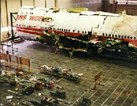TWA 800 should focus industry on fuel tank, aging aircraft issues, NTSB says

Managing Editor, AerospaceOnline.com
The National Transportation Safety Board (NTSB) today began two days of meetings in Washington, DC, to finalize its report into the July 1996 crash of TWA flight 800 into the Atlantic Ocean.
Despite the most extensive, complex and expensive investigation in the board's 33-year history, an exact cause of the crash has not been determined, and may never be. NTSB is sure about what did not bring the plane down, however.
"Let me state unequivocally," NTSB chairman James Hall said in his opening remarks, "the Safety Board found no … evidence" that a bomb or missile was responsible for the crash.

Instead, Hall urged the aviation industry to focus on fuel tank protection, the vulnerability of aircraft wiring and aging aircraft issues to help prevent any future catastrophes.
"The crash of flight 800 graphically demonstrated that, even in one of the safest transportation systems in the world, things can go horribly wrong," said Hall. "It should stand as a reminder to us all of the need for diligence and aggressive action in identifying and eliminating potential safety problems."
NTSB believes, as it has for some time, that a fuel-air explosion in the center fuel tank of the Boeing 747-131 was the cause of the in-flight breakup and eventual demise of the aircraft and all 230 persons on board.
Exactly what sparked that explosion may never be known. The board says the most likely ignition scenarios are a short circuit outside the center wing tank or excess voltage transferred to fuel quantity indication system wires.
Trying to put aside all bomb and missile theories, this morning's session featured expert testimony supporting the fuel tank scenario and discounting all others.
"Physical evidence indicates irrefutably" that a missile or bomb did not bring the aircraft down, said Dr. Bernard S. Loeb, director of the NTSB's Office of Aviation Safety.
The source of small amounts of explosive residue discovered by the FBI on some wreckage pieces, which created controversy during the investigation, was subscribed to troop ferrying operations during the Gulf War, dog-training explosive detection exercises and the recovery operations themselves.
To answer the questions posed by 258 eye witnesses to the crash that saw a "streak of light" that some believed to be a missile arcing toward the aircraft, Loeb concluded that "burning fuel from the damaged airplane likely appeared as a streak of light."
Selected reports from the NTSB investigation, including the Chairman's Factual Report, the Cockpit Voice Recorder Group Report, and the Witness Group Report, are available for download from Aerospace Online's download library.
The meetings are being Webcast live via the NTSB's website at www.ntsb.gov. Tomorrow, the board will present its final conclusions, probable cause and recommendations.
